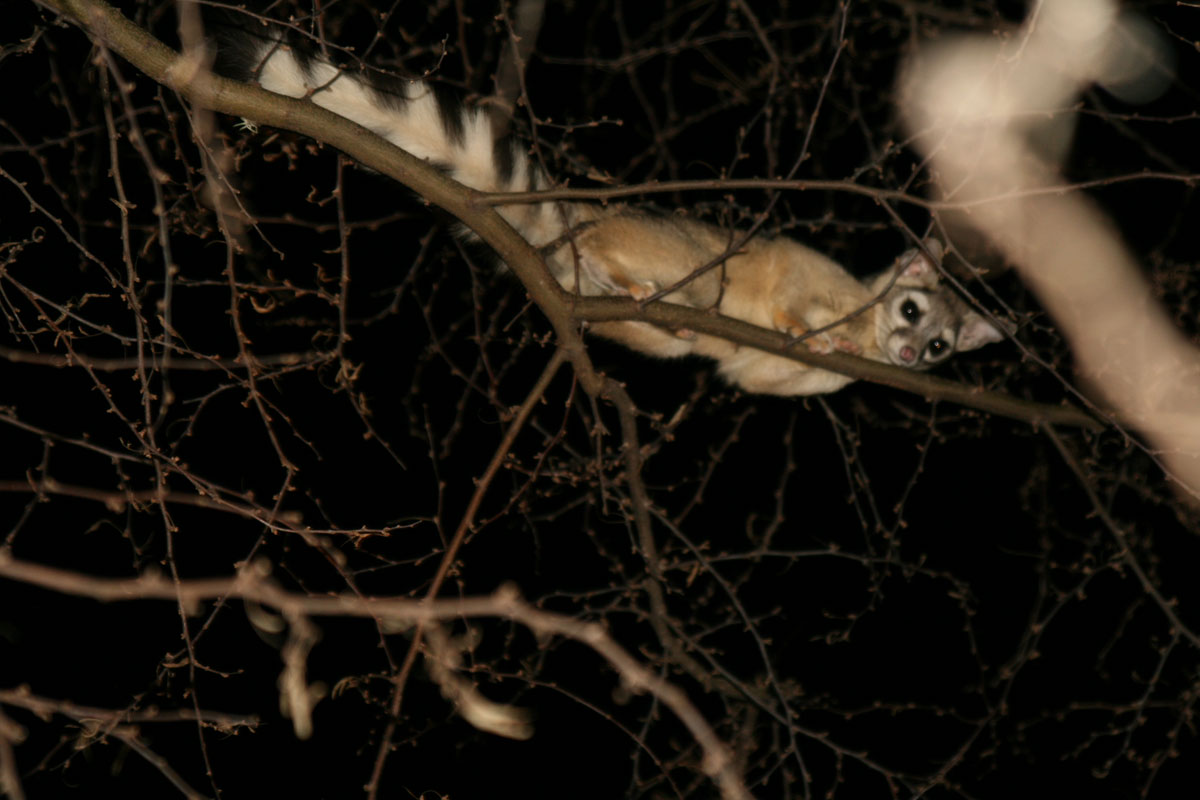Photo: A ringtail, Bassariscus astutus, in a tree outside our house.
A few years back, Susie, my wife, and I were returning from a winter trip to Santa Fe, New Mexico. About half way home at Fort Stockton, Texas, seven hours out, we got a call from our son Mark. At that time Mark lived on the farm in a house about 150 yards from ours. The conversation started off thus, “There’s an animal under your sofa and Tally bit a small hole in the sofa trying to get to the animal.” As it turned out there was a bit more to it than that.
When we arrived home after dark and about seven hours later, we found the “small” hole to be a gaping hole. The sofa was leather. Susie was not amused. It turned out that Tally, our German Shepherd, who had been staying with Mark in our absence of about a week, had gone to our house and started barking. Mark investigated and then called us.
I peered under the sofa and the frightened animal was still there hours later. I immediately identified it as a ringtail, or as my grandparents who lived in the house before us would have called it, a civet cat. After donning work gloves in case the ringtail decided to bite, I had Mark pull the heavy sofa away from the wall. I caught the ringtail, which surprisingly didn’t try to bite but instead opened its mouth wide and screamed like a banshee. I was shocked at the loud voice coming out of a cat-sized body. I carried the screaming animal out the back door and placed her on the trunk of a large hackberry tree just off the porch. The ringtail scrambled up the tree and settled on a small branch staring down at us. I photographed and left her to calm down and leave.
An investigation found the ringtail had set up house in a bedroom closet. Apparently we were gone long enough that she considered the house abandoned. Our house was built in 1908 and is not airtight. She had probably entered and exited the house via a small gap around the chimney. Although it’s possible the open back door that Tally used could have its ingress. In any event, ringtails often set up residence in our attic during the winter when temperatures don’t get too hot. The cushy closet with spare bedding must have been inviting.
Why am I writing about the ringtail in the house years later? It’s because recently some animal has been banging around on the porch roof causing our present German Shepherds, Oso and Maya, to bark in wee hours of the morning. I suspect a ringtail. The situation reminded of the earlier ringtail.
So, what is a ringtail? It’s very cute animal with a foxlike face and a lemur-like ringed tail on a cat sized body. The ringtail, Bassariscus astutus, is in the family Procyonidae, which includes raccoons and coatis. They are nocturnal and spend the day sleeping in dens, such as our attic. At night they feed on a variety of foods, including birds, rodents, reptiles, amphibians, insect, and fruits and berries.
Ringtails deliver litters of two to four babies in the spring. They range across most of Texas and are probably more common than it would seem. They are very adept at hiding and quite good at avoiding being seen. They climb as well as cats and often live in hollow trees.
Ringtails are reputedly tamable but are probably best left in the wild.
They are very cute. As one of our granddaughters, Hannah, would say, “They are soooo adorable!”


Leave a Reply